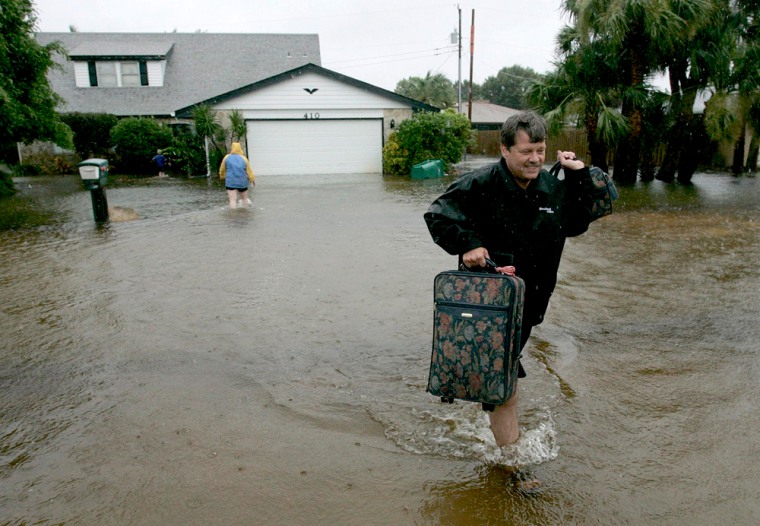Emergency crews launched airboats into submerged streets Wednesday to rescue central Florida residents trapped by rising floodwaters from a stalled Tropical Storm Fay, which soaked the state for a third consecutive day.
Calling the flooding "catastrophic," Gov. Charlie Crist requested an emergency disaster declaration from the federal government to defray rising debris and response costs. The White House said the Federal Emergency Management Agency was reviewing the request.
Flooding was reported in hundreds of homes in Brevard and St. Lucie counties, some by up to 5 feet of standing water. In three towns, rising waters backed up sewage systems. It wasn't immediately clear how many residents had been displaced or were stranded, but county officials reported making dozens of rescues.
"We can't even get out of our house," said Billie Dayton of Port St. Lucie, as waters lapped at her porch. "We're just hoping that it doesn't rain anymore."
The storm could dump 30 inches of rain in some areas of Florida and the National Hurricane Center said up to 22 inches had already fallen near Melbourne, just south of Cape Canaveral on the state's central Atlantic coast.
Slight strengthening expected
By Wednesday evening, the storm's center had moved over the Atlantic Ocean, and its winds were picking up speed.
Forecasters expected the storm to strengthen slightly before turning back toward the mainland Thursday, when it will probably hit Florida for the third time this week. But National Hurricane Center meteorologist Corey Walton said it was unlikely the storm would gain enough energy over the water to reach hurricane strength.
The erratic storm first struck Monday in the Florida Keys, then veered out to sea before traversing east across the state, briefly strengthening, then stalling. For much of Wednesday, the storm barely moved, dumping inches and inches of rain over coastal central Florida.
If Fay strikes Florida again as expected, it would be just the fourth storm in recorded history to hit the peninsula with tropical storm intensity three separate times. The most recent was Hurricane Donna in 1960, said Daniel Brown, hurricane specialist at the National Hurricane Center.
At 8 p.m. Wednesday, the storm was just off Florida's east coast, about 45 miles east-southeast of Daytona Beach. Its maximum sustained winds climbed to 60 mph, and it was expected to move slowly toward the northwest overnight.
'Everything I had is underwater'
In St. Lucie County an estimated 150 residents have been assisted in evacuating by boat or high-clearance vehicle, and water was 3 to 5 feet in some people's homes, Erick Gill, a county spokesman, said.
The Florida National Guard mobilized about a dozen guardsmen and some high-water vehicles to assist with damage assessment and help with evacuations.
Billy Johnson, 45, and his girlfriend walked four blocks through waist-high water to reach rescue vehicles after his Melbourne apartment was flooded with knee-high water.
"Everything I had is all underwater," he said. "You can't grab your food. You can't grab your TV... Grab what you can and go."
For many, however, it was just a major inconvenience.
Steve Grenon, 40, was sitting in the bed of his truck in front of his house. He said he'd been holed up there for two days, unable to leave with water was up to six feet deep in the street in front of him. A dodge sedan was partly submerged in front of him.
"I had no idea what it looked like out there until today," Grenon said.
Close calls in Florida
Gill said hundreds of homes had been flooded, though a count was incomplete. Homes also were flooded in Brevard County, said Bob Lay, the county's emergency operations director. Floodwaters also had caused sewage to back up, affecting another 40,000 to 50,000 people in three towns.
Fay formed over the weekend in the Atlantic and was blamed for 20 deaths in the Caribbean before hitting Florida's southwest coast, where it first fell short of predictions it could be a Category 1 hurricane when it came ashore.
Though no one in Florida had been killed, some were close. Joe McMannis, 27, said he jumped into floodwaters to help three people in a submerged truck in Jensen Beach. McMannis said the driver accidentally drove into a retention pond, confusing it for a driveway.
"It pretty much came up to my ears and chin," he said. "I saw this little kid coming toward me so I grabbed him and swam him back to the shore line and went back for the other two guys."
The rain was welcome in dry Florida and Georgia cropland, but could also hurt farmers' production. Forecasters predicted parts of northern Florida could get 10 to 15 inches of rain, while southern Georgia could receive 3 to 6 inches.
"They're probably areas of the state that found the rains very beneficial," said Terence McElroy, spokesman for the Florida Department of Agriculture and Consumer Services.
But McElroy said the rain could pool around and damage citrus trees and flood pastures and hay fields. He couldn't yet quantify damage.
Before moving east, the storm flooded streets in Naples, downed trees and cut power to some 95,000 homes and businesses. Tornadoes spawned by the storm damaged 51 homes in Brevard County, southeast of Orlando, including nine homes that were totaled. In the Keys, officials estimated 25,000 tourists evacuated.
In Florida communities north of the flooding and in southeast Georgia, storm preparations included canceling school, clearing storm drains and ditches and encouraging mobile home residents to find sturdier shelter.
